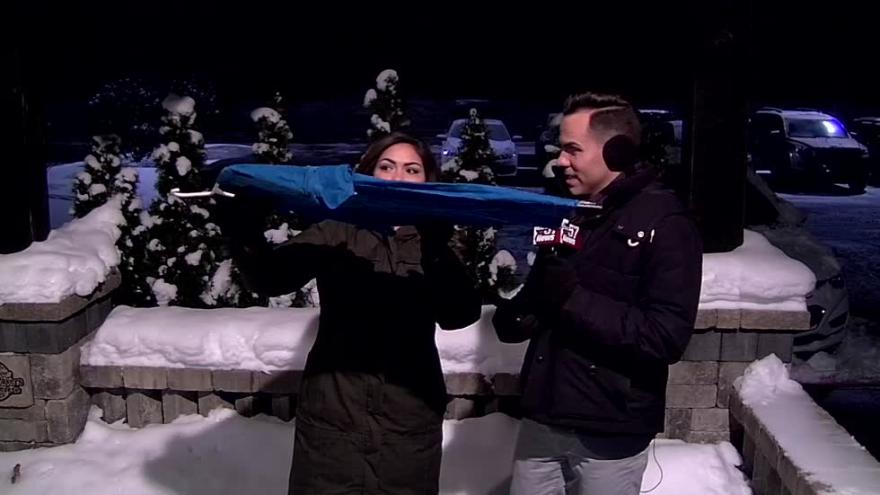It's so cold, wet clothing will freeze solid in under 10 minutes

SOUTH BEND, Ind. -- At 1:30 a.m. Tuesday, the temperature read eight degrees below zero and dropping. By 6:45 a.m., it was 13 degrees below zero, breaking a record set in 1928.
With these dangerously low temperatures recorded across the country, folks are taking advantage of science experiments.
Videos like this one have gone viral due to the temperatures and a little curiosity.
It's so cold today in New York, a little girl's bubble freezes right on her bubble wand! https://t.co/Bmb5usPUCTpic.twitter.com/VOJWq20Oyv
— ABC News (@ABC) January 2, 2018
The ABC57 Morning Team decided to conduct some experiments of our own.
1. The Frozen Bubble
Soap bubbles are simple. When air is forced into a soap-water mixture, it becomes trapped inside a soap film layer of molecules. When the bubble comes in contact with air 32 degrees Fahrenheit or below, the mixture will be begin to freeze and crystallize. During our experiment, the bubble only lasted for approximately 12 seconds before it was frozen over.
Here's how you do it:
- Mix water and dish soap in a glass.
- Use a straw to blow the bubble onto a very cold surface.
- If the bubble doesn't pop, take the straw away from the bubble.
- Watch ice crystals begin to form! The colder it is, the faster the bubble will freeze.
2. Boiling hot water + really cold air = SNOW (Well, tiny ice crystals)
Maybe you've seen this internet trend. Boiling hot water is thrown into air at a freezing temperature and snow is produced. This is made possible because hot water freezes faster than cold water during a process called "Mpemba." This experiment has an exciting visual as the water rapidly freezes, but if the water doesn't freeze all of the way, you could be burned.
How to do it:
- Pour hot or boiling water in a cup or mug.
- Go outside with plenty of room between you and others.
- Toss the water up and away from your body. Be careful!
- Watch as the water quickly freezes into tiny ice crystals and falls to the ground.
3. Frozen T-shirt
This experiment will show you why it important to stay as dry as possible during times with dangerously low temperatures. The water soaks the T-shirt and once it is put in temperatures below the freezing mark, the moisture in the fabric begins to freeze and the clothing becomes stiff with ice. Hypothermia could result from frozen clothing. Our shirt only took eight minutes to freeze at a temperature of -12 degrees.
This is how to do it:
- Use a old T-shirt or other piece of clothing.
- Run it under warm to room temperature water.
- Squeeze out excess water.
- Hang it on a hanger and place it outside in below-freezing temperatures
- Wait until the fabric is frozen. You'll notice the article of clothing will crunch as you try to move it.
The National Weather Service says being exposed to dangerously cold temperatures for too long can result in hypothermia or frostbite.



